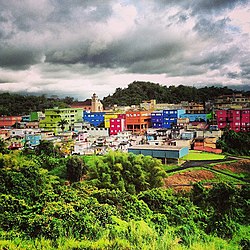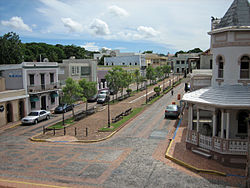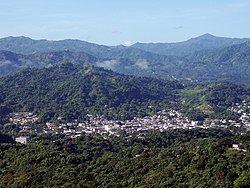| Pueblo | Designation | Municipality | Pop. (2010) | Area (sq. mi) | Plaza | Church |
|---|
| Adjuntas | barrio-pueblo | Adjuntas | 4,406 | 0.75 | Plaza Poeta Arístides Moll Boscana | San Joaquín y Santa Ana Church |
| Aguada | barrio-pueblo | Aguada | 1,324 | 0.11 | Plaza Cristóbal Colón | San Francisco de Asís Church |
| Aguadilla | barrio-pueblo | Aguadilla | 3,627 | 0.74 | Plaza Rafael Hernández Marín | San Carlos Borromeo Church |
| Aguas Buenas | barrio-pueblo | Aguas Buenas | 1,711 | 0.18 | Plaza Luis A. Ferré Aguayo | Los Tres Santos Reyes Church |
| Aibonito | barrio-pueblo | Aibonito | 3,539 | 0.80 | Plaza de Recreo de Aibonito | San José Church |
| Añasco | barrio-pueblo | Añasco | 912 | 0.09 | Plaza de Recreo de Añasco | San Antonio Abad Church |
| Arecibo | barrio-pueblo | Arecibo | 8,488 | 2.62 | Plaza Luis Muñoz Rivera | Cathedral of St. Philip the Apostle |
| Arroyo | barrio-pueblo | Arroyo | 1,206 | 0.38 | Plaza Samuel B. Morse | Nuestra Señora del Carmen Church |
| Barceloneta | barrio-pueblo | Barceloneta | 435 | 0.04 | Plaza José Cordero Rosario | Nuestra Señora del Carmen Church1 |
| Barranquitas | barrio-pueblo | Barranquitas | 2,695 | 0.77 | Plaza Pública Bicentenaria Monseñor Miguel Ángel Mendoza Rivera | San Antonio de Padua Church |
| Bayamón | barrio-pueblo | Bayamón | 4,746 | 0.64 | Plaza Licenciado Eugenio María de Hostos | Invención de la Santa Cruz Church |
| Cabo Rojo | barrio-pueblo | Cabo Rojo | 1,078 | 0.10 | Plaza Dr. Ramón Emeterio Betances y Alacán | San Miguel Arcángel Church |
| Caguas | barrio-pueblo | Caguas | 22,406 | 2.67 | Plaza Pública Santiago R. Palmer | Cathedral Dulce Nombre de Jesús |
| Camuy | barrio-pueblo | Camuy | 3,354 | 0.95 | Plaza Luis Muñoz Marín | San José Church |
| Canóvanas | barrio-pueblo | Canóvanas | 4,060 | 1.25 | Plaza Profesor Juan Francisco Arroyo Salamán | Nuestra Señora del Pilar Church |
| Carolina | barrio-pueblo | Carolina | 1,201 | 0.08 | Plaza Rey Fernando III | San Fernando Church |
| Cataño | barrio-pueblo | Cataño | 4,283 | 1.05 | Plaza de Recreo de Cataño | Nuestra Señora del Carmen Church |
| Cayey | barrio-pueblo | Cayey | 15,298 | 2.45 | Plaza Pública Ramón Frade de León | Nuestra Señora de la Asunción Church |
| Ceiba | barrio-pueblo | Ceiba | 3,677 | 0.55 | Plaza Felisa Rincón de Gautier | San Antonio de Padua Church |
| Ciales | barrio-pueblo | Ciales | 1,009 | 0.11 | Plaza Andrés Robles | Nuestra Señora del Rosario Church |
| Cidra | barrio-pueblo | Cidra | 1,064 | 0.11 | Plaza Francisco M. Zeno | Nuestra Señora del Carmen Church |
| Coamo | barrio-pueblo | Coamo | 6,685 | 0.89 | Plaza Luis Muñoz Rivera | San Blas de Illescas Church |
| Comerío | barrio-pueblo | Comerío | 3,657 | 0.40 | Plaza de la Trova | Santo Cristo de la Salud Church |
| Corozal | barrio-pueblo | Corozal | 2,631 | 0.35 | Plaza Presidente Franklin Delano Roosevelt | Sagrada Familia Church |
| Culebra | barrio-pueblo | Culebra | 462 | 0.22 | Plaza Pública de Culebra | Nuestra Señora del Carmen Church2 |
| Dorado | barrio-pueblo | Dorado | 780 | 0.07 | Plaza Pública de Dorado | San Antonio de Padua Church |
| Fajardo | barrio-pueblo | Fajardo | 13,709 | 3.23 | Plaza Antonio Rafael Barceló | Cathedral of St. James the Apostle |
| Guánica 3 | barrio-pueblo | Guánica | 3,514 | 0.98 | Plaza Manuel Jiménez | San Antonio Abad Church |
| Guayama | barrio-pueblo | Guayama | 16,891 | 2.47 | Plaza Cristóbal Colón | San Antonio de Padua Church |
| Guayanilla | barrio-pueblo | Guayanilla | 3,757 | 0.54 | Plaza Luis Muñoz Marín | Inmaculada Concepción Church |
| Guaynabo | barrio-pueblo | Guaynabo | 4,008 | 0.59 | Plaza de Recreo Guaynabo | San Pedro Mártir Church |
| Gurabo | barrio-pueblo | Gurabo | 1,509 | 0.11 | Plaza Pública de Gurabo | San José Church |
| Hatillo | barrio-pueblo | Hatillo | 3,117 | 0.84 | Plaza José R. Millán | Nuestra Señora del Carmen Church |
| Hormigueros | barrio-pueblo | Hormigueros | 1,204 | 0.23 | Plaza Ramón S. Vélez Ramírez | Basilica of the Our Lady of Monserrat |
| Humacao | barrio-pueblo | Humacao | 3,862 | 0.64 | Plaza Luis Muñoz Rivera | Dulce Nombre de Jesús Co-Cathedral |
| Isabel II | barrio-pueblo | Vieques | 1,207 | 0.50 | Plaza Pública de Vieques Luis Muñoz Rivera | Santiago Apóstol Church |
| Isabela | barrio-pueblo | Isabela | 7,826 | 1.46 | Plaza Manuel María Corchado y Juarbe | San Antonio de Padua Church |
| Jayuya | barrio-pueblo | Jayuya | 1,222 | 0.14 | Plaza Nemesio Rosario Canales Rivera | Nuestra Señora de la Monserrate Church |
| Juana Díaz | barrio-pueblo | Juana Díaz | 3,977 | 0.51 | Plaza Román Baldorioty de Castro | San Ramón Nonato Church |
| Juncos | barrio-pueblo | Juncos | 2,464 | 0.37 | Plaza de Recreo Antonio R. Barceló | Inmaculada Concepción Church |
| Lajas | barrio-pueblo | Lajas | 564 | 0.06 | Plaza Juan Ramírez Ortiz | Nuestra Señora De Candelaria Church |
| Lares | barrio-pueblo | Lares | 2,690 | 0.58 | Plaza de la Revolución | San José Church |
| Las Marías | barrio-pueblo | Las Marías | 262 | 0.06 | Plaza San Carlos | Inmaculado Corazón de María Church |
| Las Piedras | barrio-pueblo | Las Piedras | 1,500 | 0.18 | Plaza de Recreo Las Piedras | Inmaculada Concepción Church |
| Loíza | barrio-pueblo | Loíza | 3,875 | 0.66 | Plaza Pública de Loíza | Espíritu Santo y San Patricio Church |
| Luquillo | barrio-pueblo | Luquillo | 1,028 | 0.25 | Plaza Rosendo Matienzo Cintrón | San José Church |
| Manatí | barrio-pueblo | Manatí | 5,746 | 0.77 | Plaza Luis Muñoz Rivera | Nuestra Señora de la Candelaria Church |
| Maricao | barrio-pueblo | Maricao | 716 | 0.11 | Plaza Pública de Maricao Luis Muñoz Rivera | San Juan Bautista Church |
| Maunabo | barrio-pueblo | Maunabo | 317 | 0.14 | Plaza de Recreo de Maunabo | San Isidro Labrador Church |
| Mayagüez | barrio-pueblo | Mayagüez | 26,903 | 2.98 | Plaza Pública Cristóbal Colón | Cathedral of Our Lady of the Candelaria |
| Moca | barrio-pueblo | Moca | 1,735 | 0.32 | Plaza José D. Quiñones | Nuestra Señora de la Monserrate Church |
| Morovis | barrio-pueblo | Morovis | 895 | 0.07 | Plaza Don Juan Evangelista Rivera | Nuestra Senora del Carmen Church |
| Naguabo | barrio-pueblo | Naguabo | 1,514 | 0.25 | Plaza Luis Muñoz Rivera | Nuestra Señora del Rosario Church |
| Naranjito | barrio-pueblo | Naranjito | 1,157 | 0.12 | Plaza de Recreo de Naranjito | San Miguel Arcángel Church |
| Orocovis | barrio-pueblo | Orocovis | 682 | 0.11 | Plaza Juan Rivera de Santiago | San Juan Bautista Church |
| Patillas | barrio-pueblo | Patillas | 2,279 | 0.49 | Plaza Pública de Patillas Adelina Cintrón | Inmaculado Corazón de María Church |
| Peñuelas | barrio-pueblo | Peñuelas | 1,422 | 0.25 | Plaza Pública de Peñuelas | San José Church |
| Ponce 4 | consolidated | Ponce | 17,152 | 1.42 | Plaza Las Delicias | Cathedral of Our Lady of Guadalupe |
| Pueblo (Río Piedras) 5 | barrio | San Juan | 8,720 | 0.73 | Plaza de la Convalecencia | Nuestra Señora del Pilar Church |
| Quebradillas | barrio-pueblo | Quebradillas | 3,103 | 0.65 | Plaza Luis Muñoz Rivera | San Rafael Church |
| Rincón | barrio-pueblo | Rincón | 933 | 0.12 | Plaza Pública de Rincón | Santa Rosa de Lima Church |
| Río Grande | barrio-pueblo | Río Grande | 1,772 | 0.20 | Plaza Pública de Río Grande | Nuestra Señora del Carmen Church |
| Sabana Grande | barrio-pueblo | Sabana Grande | 1,554 | 0.11 | Plaza Pública de Sabana Grande José A. Busigo | San Isidro Labrador Church |
| Salinas | barrio-pueblo | Salinas | 2,453 | 0.46 | Plaza Las Delicias | Nuestra Señora de la Monserrate Church |
| San Germán | barrio-pueblo | San Germán | 2,660 | 0.33 | Plaza Francisco Mariano Quiñones | San Germán de Auxerre Church |
| San Juan Antiguo | barrio | San Juan | 7,085 | 2.63 | Plaza de Armas | Cathedral Basilica of Saint John the Baptist 6 |
| San Lorenzo | barrio-pueblo | San Lorenzo | 2,045 | 0.22 | Plaza Pública de San Lorenzo Policarpo Santana | Las Mercedes Church |
| San Sebastián | barrio-pueblo | San Sebastián | 1,424 | 0.12 | Plaza Ángel Gabriel Mislán Huertas | San Sebastián Mártir Church |
| Santa Isabel | barrio-pueblo | Santa Isabel | 5,133 | 0.87 | Plaza de los Fundadores7 | Santiago Apóstol Church |
| Toa Alta | barrio-pueblo | Toa Alta | 397 | 0.03 | Plaza Pública de Toa Alta | San Fernando Rey Church |
| Toa Baja | barrio-pueblo | Toa Baja | 565 | 0.05 | Plaza Virgilio Dávila | San Pedro Apostol Church |
| Trujillo Alto | barrio-pueblo | Trujillo Alto | 673 | 0.15 | Plaza Pública de Trujillo Alto | Exaltación de la Santa Cruz Church |
| Utuado | barrio-pueblo | Utuado | 5,856 | 1.19 | Plaza Pública de Utuado Sebastián Morfi | San Miguel Arcángel Church |
| Vega Alta | barrio-pueblo | Vega Alta | 1,169 | 0.10 | Plaza Gilberto Concepción de Gracia | Inmaculada Concepción Church |
| Vega Baja | barrio-pueblo | Vega Baja | 816 | 0.11 | Plaza José Francisco Náter | Santa María del Rosario Church |
| Villalba | barrio-pueblo | Villalba | 729 | 0.15 | Plaza José Ramón Figueroa Rivera | Nuestra Señora del Carmen Church |
| Yabucoa | barrio-pueblo | Yabucoa | 2,593 | 0.52 | Plaza Pública de Yabucoa | Church of the Holy Guardian Angels |
| Yauco | barrio-pueblo | Yauco | 3,091 | 0.32 | Plaza Pública Fernando de Pacheco y Matos | Church of the Holy Rosary |




















